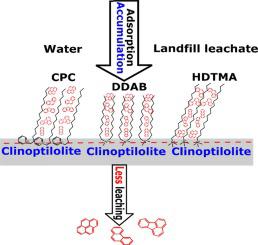Waste Management ( IF 7.1 ) Pub Date : 2021-07-15 , DOI: 10.1016/j.wasman.2021.06.033 Monireh S Hedayati 1 , Otman Abida 2 , Loretta Y Li 1

|
The authors report the potential adsorption capacities of three surfactant-modified clinoptilolites (MC)—cetylpyridinium chloride (CPC)-MC, didodecyldimethylammonium bromide (DDAB)-MC, and hexadecyltrimethylammonium bromide (HDTMA)-MC—for the removal of polycyclic aromatic hydrocarbons (PAHs) from aquatic environments and landfill leachate. A liquid–liquid extraction method was used to extract PAHs from water and GC/MS was used to analyse the PAHs. PAH accumulations on CPC-MC, DDAB-MC, and HDTMA-MC were linear over 21 successive batch adsorption tests for anthracene (708, 737, and 750 µg/g), fluoranthene (1355, 1583, and 1303 µg/g), fluorene (973, 1060, and 1147 µg/g), phenanthrene (844, 1057, and 989 µg/g), and pyrene (1343, 1569, and 1269 µg/g). The leachability after 21 successive accumulations was <2% for anthracene, <4% for fluoranthene, <3% for fluorene, <4% for pyrene, and <5% for phenanthrene for each adsorbent. PAH removals from landfill leachate for anthracene, fluoranthene, fluorene, phenanthrene, and pyrene were 97.8%, 98.6%, 95.7%, 97.0%, and 98.5% for CPC-MC and 99.0%, 99.6%, 98.0%, 99.0%, and 99.6% for DDAB-MC, respectively, meeting the fresh water quality standards established by British Columbia and the World Health Organization (WHO) for anthracene, fluoranthene, and fluorene. The molecular weight and molecular structure of PAHs and the hydrophobicity of adsorbents can fundamentally influence the PAH adsorption mechanism based on π–π stacking.
中文翻译:

表面活性剂改性斜发沸石吸附多环芳烃处理垃圾渗滤液
作者报告了三种表面活性剂改性的斜发沸石 (MC)——十六烷基氯化吡啶 (CPC)-MC、双十二烷基二甲基溴化铵 (DDAB)-MC 和十六烷基三甲基溴化铵 (HDTMA)-MC——用于去除多环芳烃的潜在吸附能力。 PAHs) 来自水生环境和垃圾填埋场渗滤液。使用液-液萃取法从水中提取多环芳烃,并使用 GC/MS 分析多环芳烃。在蒽(708、737 和 750 µg/g)、荧蒽(1355、1583 和 1303 µg/g)的 21 次连续批次吸附试验中,CPC-MC、DDAB-MC 和 HDTMA-MC 上的 PAH 积累呈线性关系,芴(973、1060 和 1147 µg/g)、菲(844、1057 和 989 µg/g)和芘(1343、1569 和 1269 µg/g)。21 次连续积累后的浸出率对于蒽 <2%,对于荧蒽 <4%,对于每种吸附剂,芴 <3%,芘 <4%,菲 <5%。垃圾渗滤液中蒽、荧蒽、芴、菲和芘的 PAH 去除率分别为 97.8%、98.6%、95.7%、97.0% 和 98.5% 的 CPC-MC 和 99.0%、99.6%、98.0% 和 98.0% DDAB-MC 分别为 99.6%,符合不列颠哥伦比亚省和世界卫生组织 (WHO) 为蒽、荧蒽和芴制定的淡水质量标准。PAHs的分子量和分子结构以及吸附剂的疏水性可以从根本上影响基于π-π堆积的PAH吸附机制。CPC-MC 分别为 0% 和 98.5%,DDAB-MC 分别为 99.0%、99.6%、98.0%、99.0% 和 99.6%,符合不列颠哥伦比亚省和世界卫生组织 (WHO) 制定的淡水质量标准) 表示蒽、荧蒽和芴。PAHs的分子量和分子结构以及吸附剂的疏水性可以从根本上影响基于π-π堆积的PAH吸附机制。CPC-MC 分别为 0% 和 98.5%,DDAB-MC 分别为 99.0%、99.6%、98.0%、99.0% 和 99.6%,满足不列颠哥伦比亚省和世界卫生组织 (WHO) 制定的淡水质量标准) 表示蒽、荧蒽和芴。PAHs的分子量和分子结构以及吸附剂的疏水性可以从根本上影响基于π-π堆积的PAH吸附机制。











































 京公网安备 11010802027423号
京公网安备 11010802027423号